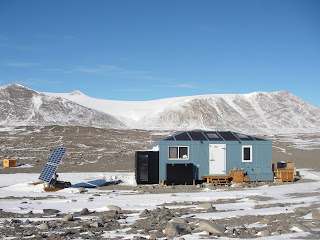Summer time has arrived as have hundreds of summer workers for the summer season of mid October to mid February. The galley is now quite crowded and the granola, grape-nuts and yogurt go faster, but it also means more friendly faces are back in town, with still more to come in the next few weeks.
The sun has still been setting but it only has until the 16th or so and then it will be above the horizon continually until around February 20th. It makes the evening twilight that much more special. Twilight has always been my favorite time of the day, and when it lasts a long time yet won't last through the month, it is something to not take for granted. So the other night, just before bed, I went over to the solar shop to switch out some batteries that were charging, I decided to hike up Observation Hill. It was windy and past my bedtime, but I couldn't pass up the opportunity to get up there to see the twilight and look over the ice, the Royal Society Mountains, McMurdo and New Zealand's Scott Base. So up I went.
 |
| Twilight, almost like seeing it from space. |
 |
| The side of Ob Hill, the Sea Ice Runway in the background. |
 |
| The cross was erected 100 years ago in memory of Scott's party that perished on the return from the South Pole. |
 |
| The glorious moon high above Mac Town. |
I paid the price and was exhausted the rest of the week, but it is now Sunday afternoon - trying to do a quick recovery on my one day off a week. I spent the week preparing MFPS units. (Mobile Field Power Stations). Each yellow box has two 30 Ah, 12 Volt batteries, a battery charger and an inverter for AC power.
 |
| Getting ready for the influx of scientists! |
Then I worked on Fish Hut #5 getting it ready for another group. This module will be dragged out to their spot on the sea ice, if the sea ice is cooperating. It is unusually thin now and cracks have threatened scientists usual research locations. We will see.
 |
| Fish Hut #5 now electrically ready for the Weddell Seal scientists. |
We also got the South Pole Visitor Center solar array out and tested.
Now it is hanging out soaking in the sun and hopefully people are
noticing it and wondering why we don't have solar arrays everywhere on
the station!
 |
| The South Pole Visitor Center array, batts, inverter and charger. |
And I played what may have been the first Antarctic game of Pickle Ball! For those who do not know, Pickle Ball was one of my favorite gym games...after floor hockey, of course. Floor hockey not being allowed, one has to do what one can. So I got permission, painted lines on the floor (green, of course) after work and had the carpenters make some posts, and finally got out my net, paddles and plastic balls. It was wonderful to play after close to 15 years without a game. It is perfect for McMurdo and hopefully I'll get a good group of racquet sport enthusiasts to join in with me.
My sign language class is going very well. It is great to be signing each week and generating some excited new signers! Soon it will be ASL class on Tuesday nights, Pickle Ball on Wednesdays and I'm starting an indoor soccer group on Thursdays! The summer will be busy, but hopefully lots of fun.
It is wonderful to have regular flights to the station because it means we get fresh fruit again. How wonderful to have a banana, an apple or an orange! I also found out the snow mobile mechanic that that works in the same shop has been a space shuttle technician for 11 years! Well, that's the week behind! The week ahead has more prep and maybe a trip out to a science camp!
Some interesting links:
The Antarctic newspaper:
http://antarcticsun.usap.gov/
The McMurdo webcam: http://www.usap.gov/videoclipsandmaps/mcmwebcam.cfm



















































